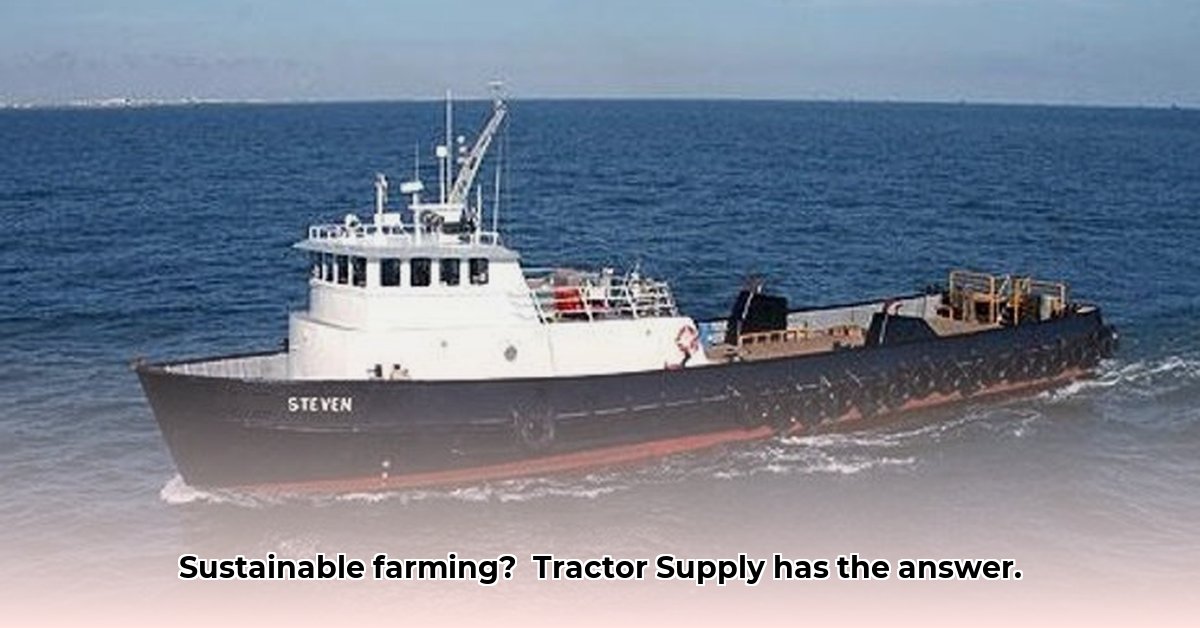
Tractor Supply Boats: Myth or Misunderstood Marvel?
The phrase "tractor supply boats" evokes images of sturdy vessels ferrying farm equipment across waterways. While a dedicated "tractor supply boat" category doesn't officially exist, the underlying need for efficient water transport in sustainable agriculture is undeniable. This guide explores practical solutions farmers employ, focusing on sustainable practices. We'll debunk the myth of a singular "tractor supply boat" and highlight the diverse options available. For more on farm equipment, check out this helpful resource: Farm Equipment Guide.
Real-World Solutions for Sustainable Water Transport in Farming
Instead of searching for a mythical vessel, let's examine practical, eco-friendly water transport methods for farms:
Pontoon Boats: These stable, flat-bottomed boats offer high cargo capacity, making them ideal for transporting supplies, even on uneven shorelines. Their versatility makes them suitable for diverse farming needs.
Jon Boats and Aluminum Boats: Lighter and more maneuverable, these are cost-effective choices for navigating shallow waters and smaller waterways commonly found in rural areas. Their smaller size allows for easier access to more isolated locations.
Custom-Built Flat-Bottom Boats: For larger operations or substantial cargo, custom-built flat-bottom boats provide the necessary capacity, though they come with higher initial and maintenance costs. These can be tailored to specific cargo requirements, maximizing efficiency.
Drones: Drone technology offers an efficient solution for transporting smaller items like seeds, pesticides, or small tools, particularly to remote areas. However, regulations and weather conditions need careful consideration.
Choosing the Right Watercraft: A Comparative Analysis
Selecting the appropriate watercraft depends heavily on specific operational requirements. The table below provides a comparative analysis of various options:
| Factor | Small Jon Boat | Pontoon Boat | Larger Flat-bottom | Drones |
|---|---|---|---|---|
| Cargo Capacity | Low | Medium-High | High | Very Low |
| Maneuverability | Excellent | Good | Limited | Excellent |
| Water Conditions | Shallow Waters | Moderate Depth | Deep Water | Varies |
| Initial Cost | Low | Medium | High | Medium |
| Maintenance Cost | Low | Medium | High | Medium |
| Environmental Impact | Relatively Low | Relatively Low | Potentially Higher | Relatively Low |
Do you find yourself struggling to balance cost, capacity, and environmental impact? Many farmers face this challenge. A careful evaluation of your specific needs is critical for making an informed decision.
Sustainable Practices: Minimizing Environmental Impact
Regardless of the chosen watercraft, environmentally responsible practices are crucial in sustainable agriculture. These include:
Fuel Efficiency: Optimize routes and use fuel-efficient engines to minimize emissions. Did you know that even small changes in engine maintenance can drastically improve fuel efficiency?
Pollution Prevention: Regular boat maintenance prevents leaks and spills, while proper waste disposal minimizes water contamination. Failing to address these issues can have seriously negative consequences on the surrounding ecosystem.
Wildlife Protection: Maintain safe distances from wildlife habitats and avoid disturbing nesting areas to preserve biodiversity. Responsible navigation helps ensure the health and vitality of aquatic life.
Adherence to Regulations: Always abide by local and federal boating laws and regulations. Ignoring these can lead to significant fines and potentially endanger the environment.
How to Overcome Challenges in Adopting Precision Farming for Sustainable Agriculture
Precision farming technologies possess immense potential to enhance resource efficiency and yield in sustainable agriculture. However, several challenges hinder widespread adoption. Let's examine these obstacles and explore potential solutions.
Key Takeaways:
- Precision farming offers significant potential for enhancing sustainable agricultural practices.
- Data management, technology accessibility, and privacy concerns represent significant hurdles.
- Overcoming these requires a comprehensive approach integrating technological advancements, support systems, and policy changes.
- Successful precision farming implementation necessitates strategic investments, education, and collaboration.
- The long-term advantages – improved resource utilization and higher yields – far outweigh the initial investment.
Data Management: Mastering the Information Overflow
The sheer volume of data generated by precision farming technologies presents a major challenge. Effective data management is crucial for leveraging this information effectively. This means investing in user-friendly software, streamlining data formats, and prioritizing relevant data points. Failing to address this leads to inefficiencies and missed opportunities.
Technology Access: Bridging the Digital Divide
Unequal access to precision farming technologies creates an affordability barrier for many farmers, particularly smaller operations. Government subsidies, leasing programs, and collaborative farming models can help mitigate these issues. Remember, access to technology is a cornerstone of sustainable agricultural advancement.
Data Privacy: Building Trust and Security
Data privacy and security are paramount concerns in precision farming. Clear regulations, secure data-sharing platforms, and robust cybersecurity measures are necessary to ensure farmer trust and protect sensitive information. A lack of trust can hinder adoption.
Precision Farming: A Tailored Approach for Every Farm
Precision farming isn't a one-size-fits-all solution. The ideal approach varies based on factors like crop type, soil conditions, farm size, and water management strategies. A holistic perspective is required to ensure successful implementation and optimize results.
The Long-Term Vision: Sustainability through Innovation
While the initial investment in precision farming can be substantial, the long-term benefits significantly outweigh the upfront costs. Reduced resource consumption, enhanced yields, and minimized environmental impact all contribute to more sustainable farming practices. It's an investment in the future of agriculture.